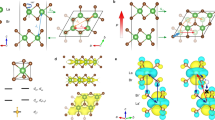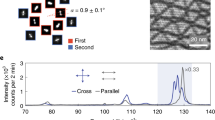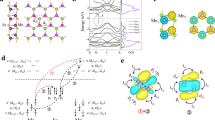Abstract
Moiré engineering1,2,3 of van der Waals magnetic materials4,5,6,7,8,9 can yield new magnetic ground states via competing interactions in moiré superlattices10,11,12,13. Theory predicts a suite of interesting phenomena, including multiflavour magnetic states10, non-collinear magnetic states10,11,12,13, moiré magnon bands and magnon networks14 in twisted bilayer magnetic crystals, but so far such non-trivial magnetic ground states have not emerged experimentally. Here, by utilizing the stacking-dependent interlayer exchange interactions in two-dimensional magnetic materials15,16,17,18, we demonstrate a coexisting ferromagnetic (FM) and antiferromagnetic (AF) ground state in small-twist-angle CrI3 bilayers. The FM–AF state transitions to a collinear FM ground state above a critical twist angle of about 3°. The coexisting FM and AF domains result from a competition between the interlayer AF coupling, which emerges in the monoclinic stacking regions of the moiré superlattice, and the energy cost for forming FM–AF domain walls. Our observations are consistent with the emergence of a non-collinear magnetic ground state with FM and AF domains on the moiré length scale10,11,12,13. We further employ the doping dependence of the interlayer AF interaction to control the FM–AF state by electrically gating a bilayer sample. These experiments highlight the potential to create complex magnetic ground states in twisted bilayer magnetic crystals, and may find application in future gate-voltage-controllable high-density magnetic memory storage.
This is a preview of subscription content, access via your institution
Access options
Access Nature and 54 other Nature Portfolio journals
Get Nature+, our best-value online-access subscription
$29.99 / 30 days
cancel any time
Subscribe to this journal
Receive 12 print issues and online access
$259.00 per year
only $21.58 per issue
Buy this article
- Purchase on Springer Link
- Instant access to full article PDF
Prices may be subject to local taxes which are calculated during checkout





Similar content being viewed by others
Data availability
The source data that support the findings of this study are available within the paper. Additional data are available from the authors upon reasonable request. Source data are provided with this paper.
References
Andrei, E. Y. & MacDonald, A. H. Graphene bilayers with a twist. Nat. Mater. 19, 1265–1275 (2020).
Balents, L., Dean, C. R., Efetov, D. K. & Young, A. F. Superconductivity and strong correlations in moiré flat bands. Nat. Phys. 16, 725–733 (2020).
Kennes, D. M. et al. Moiré heterostructures as a condensed-matter quantum simulator. Nat. Phys. 17, 155–163 (2021).
Gong, C. et al. Discovery of intrinsic ferromagnetism in two-dimensional van der Waals crystals. Nature 546, 265–269 (2017).
Huang, B. et al. Layer-dependent ferromagnetism in a van der Waals crystal down to the monolayer limit. Nature 546, 270–273 (2017).
Burch, K. S., Mandrus, D. & Park, J.-G. Magnetism in two-dimensional van der Waals materials. Nature 563, 47–52 (2018).
Gong, C. & Zhang, X. Two-dimensional magnetic crystals and emergent heterostructure devices. Science 363, eaav4450 (2019).
Mak, K. F., Shan, J. & Ralph, D. C. Probing and controlling magnetic states in 2D layered magnetic materials. Nat. Rev. Phys. 1, 646–661 (2019).
Gibertini, M., Koperski, M., Morpurgo, A. F. & Novoselov, K. S. Magnetic 2D materials and heterostructures. Nat. Nanotechnol. 14, 408–419 (2019).
Hejazi, K., Luo, Z.-X. & Balents, L. Noncollinear phases in moiré magnets. Proc. Natl Acad. Sci. USA 117, 10721 (2020).
Tong, Q., Liu, F., Xiao, J. & Yao, W. Skyrmions in the Moiré of van der Waals 2D magnets. Nano Lett. 18, 7194–7199 (2018).
Akram, M. & Erten, O. Skyrmions in twisted van der Waals magnets. Phys. Rev. B 103, L140406 (2021).
Xiao, F., Chen, K. & Tong, Q. Magnetization textures in twisted bilayer CrX3 (X = Br, I). Phys. Rev. Res. 3, 013027 (2021).
Wang, C., Gao, Y., Lv, H., Xu, X. & Xiao, D. Stacking domain wall magnons in twisted van der Waals magnets. Phys. Rev. Lett. 125, 247201 (2020).
Li, T. et al. Pressure-controlled interlayer magnetism in atomically thin CrI3. Nat. Mater. 18, 1303–1308 (2019).
Song, T. et al. Switching 2D magnetic states via pressure tuning of layer stacking. Nat. Mater. 18, 1298–1302 (2019).
Chen, W. et al. Direct observation of van der Waals stacking-dependent interlayer magnetism. Science 366, 983 (2019).
Klein, D. R. et al. Enhancement of interlayer exchange in an ultrathin two-dimensional magnet. Nat. Phys. 15, 1255–1260 (2019).
Sivadas, N., Okamoto, S., Xu, X., Fennie, C. J. & Xiao, D. Stacking-dependent magnetism in bilayer CrI3. Nano Lett. 18, 7658–7664 (2018).
Li, S. et al. Magnetic-field-induced quantum phase transitions in a van der Waals magnet. Phys. Rev. 10, 011075 (2020).
Yoo, H. et al. Atomic and electronic reconstruction at the van der Waals interface in twisted bilayer graphene. Nat. Mater. 18, 448–453 (2019).
Kim, K. et al. van der Waals heterostructures with high accuracy rotational alignment. Nano Lett. 16, 1989–1995 (2016).
Cao, Y. et al. Superlattice-induced insulating states and valley-protected orbits in twisted bilayer graphene. Phys. Rev. Lett. 117, 116804 (2016).
Chung, T.-F., Xu, Y. & Chen, Y. P. Transport measurements in twisted bilayer graphene: electron–phonon coupling and Landau level crossing. Phys. Rev. B 98, 035425 (2018).
Jiang, S., Li, L., Wang, Z., Mak, K. F. & Shan, J. Controlling magnetism in 2D CrI3 by electrostatic doping. Nat. Nanotechnol. 13, 549–553 (2018).
Huang, B. et al. Electrical control of 2D magnetism in bilayer CrI3. Nat. Nanotechnol. 13, 544–548 (2018).
Jiang, S., Shan, J. & Mak, K. F. Electric-field switching of two-dimensional van der Waals magnets. Nat. Mater. 17, 406–410 (2018).
Chen, L. et al. Topological spin excitations in honeycomb ferromagnet CrI3. Phys. Rev. 8, 041028 (2018).
McGuire, M. A., Dixit, H., Cooper, V. R. & Sales, B. C. Coupling of crystal structure and magnetism in the layered, ferromagnetic insulator CrI3. Chem. Mater. 27, 612–620 (2015).
Akram, M. et al. Moiré skyrmions and chiral magnetic phases in twisted CrX3 (X = I, Br, Cl) bilayers. Nano Lett. 21, 6633–6639 (2021).
Zener, C. Classical theory of the temperature dependence of magnetic anisotropy energy. Phys. Rev. 96, 1335–1337 (1954).
Niitsu, K., Tanigaki, T., Harada, K. & Shindo, D. Temperature dependence of 180° domain wall width in iron and nickel films analyzed using electron holography. Appl. Phys. Lett. 113, 222407 (2018).
Bai, Y. et al. Excitons in strain-induced one-dimensional moiré potentials at transition metal dichalcogenide heterojunctions. Nat. Mater. 19, 1068–1073 (2020).
Tate, M. W. et al. High dynamic range pixel array detector for scanning transmission electron microscopy. Microsc. Microanal. 22, 237–249 (2016).
Cueva, P., Hovden, R., Mundy, J. A., Xin, H. L. & Muller, D. A. Data processing for atomic resolution electron energy loss spectroscopy. Microsc. Microanal. 18, 667–675 (2012).
Acknowledgements
This work was supported by the Air Force Office of Scientific Research MURI under award FA9550-18-1-0480 (device fabrication and TEM characterization) and FA9550-19-1-0390 (MCD measurements). It was partially supported by the National Science Foundation under DMR-1807810 (modelling) and the Cornell Center for Materials Research with funding from the NSF MRSEC program under DMR-1719875 (Raman and structural characterization). Funding for J.E.G. was provided by the Center for Emergent Materials: an NSF MRSEC under award number DMR-2011876. D.W. acknowledges financial support by the German Science Foundation (Deutsche Forschungsgemeinschaft, DFG) under fellowship number WE6480/1. K.F.M. acknowledges support from a David and Lucille Packard Fellowship. Growth of the hBN crystals was supported by the Elemental Strategy Initiative of MEXT, Japan and CREST (JPMJCR15F3), JST.
Author information
Authors and Affiliations
Contributions
Y.X. fabricated the devices and performed the MCD measurements and analysis. A.R. and Y.-T.S. performed the TEM measurements and analysis under the guidance of D.A.M. S.J. provided assistance in the MCD measurements. K.L. performed the Raman measurements. D.W. and J.E.G. grew the bulk CrI3 crystals. K.W. and T.T. grew the bulk hBN crystals. Y.X., K.F.M. and J.S. designed the scientific objectives and co-wrote the manuscript. All authors discussed the results and commented on the manuscript.
Corresponding authors
Ethics declarations
Competing interests
The authors declare no competing interests.
Additional information
Peer review information Nature Nanotechnology thanks Xin Lu and the other, anonymous, reviewer(s) for their contribution to the peer review of this work.
Publisher’s note Springer Nature remains neutral with regard to jurisdictional claims in published maps and institutional affiliations.
Extended data
Extended Data Fig. 1 Tear-and-stack method.
a-c, Optical images taken during the preparation of a twisted bilayer CrI3 sample. The monolayer in a is torn apart partially (outlined by the black dashed curves) and picked up by an hBN flake, leaving the remaining portion on the substrate. The remaining portion in b (outlined by the red dashed curves) is rotated by an angle θ. The two monolayers of CrI3 are finally engaged to form a twisted bilayer (c). The scale bar is 10 micrometers.
Extended Data Fig. 2 Polarization-resolved Raman spectrum of twisted bilayer CrI3.
a, Schematics of a moiré superlattice structure formed by small-twist-angle bilayer CrI3. R, M and AA denote rhombohedral, monoclinic and AA stacking order, respectively. The blue lines denote the direction of the major axis in the corresponding M region. The three axes are related to each other by a 120° rotation. b,c, Raman spectrum of a 1.2° (b) and a 2.0° (c) twisted bilayer as a function of polarization angle of the excitation. The linear polarization of the incident light is rotated by a half-wave-plate and cross-polarized Raman spectra are recorded. This is equivalent to recording cross-polarized Raman spectra for a rotating sample. Isotropic response is observed, as expected from the three-fold rotational symmetry of the major axis of the M regions.
Extended Data Fig. 3 Correlated STEM and MCD studies (sample 1).
a, Optical image of the sample for the STEM measurements shown in Fig. 1. The scale bar is 20 micrometers. b,c, Sum of the STEM dark field images in Fig. 1d–f before (b) and after (c) applying a sigma=1.25 pixel Gaussian filter. Since the image is constructed from the third-order diffraction spots from twisted CrI3, the true moiré period is three times the value shown in this figure. The scale bars are 25 nm. d, MCD measurement performed on the same sample area. No significant changes were observed in the MCD before and after the STEM measurements.
Extended Data Fig. 4 Correlated STEM and MCD studies (sample 2).
a-d, Electron diffraction and the corresponding real-space dark field moiré fringe patterns for sample 2, with the twist angle estimated to be 2.4 ± 0.5°. The target twist angle is 2°. e, MCD measurement performed on the same sample area.
Extended Data Fig. 5 Large field-of-view dark-field TEM image (sample 2).
Electron-beam diffraction pattern (a) and real-space dark-field moiré fringe pattern (b). The image in b is constructed from the second-order diffraction peak of CrI3 selected by the dark-field mask shown in yellow in a. The true moiré period is two times the value shown in b. The scale bar is 150 nm.
Extended Data Fig. 6 Temperature dependent AC susceptibility (15°-twist sample).
The inset shows the sample and the AC susceptibility measurement schematic. An AC current through the metallic ring structure is used to generate a small oscillating magnetic field of a few Oe. The AC susceptibility is measured using MCD as \(\chi \prime = \frac{{\partial MCD}}{{\partial H}}\) (details of the method are described in ref. 25). The twisted bilayer region (red) shows a single divergent peak of \(\chi \prime (T)\), indicating FM coupling of the two layers and the absence of uncoupled regions. The Curie temperature is ~ 6 K higher in the twist bilayer than in the isolated monolayer region (black).
Extended Data Fig. 7
Additional MCD data at 4 K for samples with twist angles 0.8° (a), 1.5° (b) and 2.6° (c).
Extended Data Fig. 8 Additional MCD imaging data.
a, Map of \(MCD(1T) - MCD(0T)\) for 15°-twist bilayer CrI3. No AF contribution is observed as expected. b, Map of \(MCD(0T)\) (left) and \(MCD\left( {1T} \right) - MCD(0T)\) (right) for a 60° sample. Only FM contribution is seen. The black and red dashed lines outline the constituent CrI3 monolayers. The MCD(0T) image was taken after the sample is polarized at B = 1 T.
Extended Data Fig. 9 Temperature dependence in natural bilayer CrI3.
MCD versus magnetic field in a natural bilayer CrI3 at different temperatures (a) and the temperature dependence of the spin-flip transition field Bc (b). Bc is the average spin-flip transition field between forward and backward sweeps. The error bars are estimated from the width of the transition.
Extended Data Fig. 10
Additional gate-dependent MCD response at 4 K for another sample with θ = 1.6°.
Source data
Rights and permissions
About this article
Cite this article
Xu, Y., Ray, A., Shao, YT. et al. Coexisting ferromagnetic–antiferromagnetic state in twisted bilayer CrI3. Nat. Nanotechnol. 17, 143–147 (2022). https://doi.org/10.1038/s41565-021-01014-y
Received:
Accepted:
Published:
Issue Date:
DOI: https://doi.org/10.1038/s41565-021-01014-y
This article is cited by
-
Multistep magnetization switching in orthogonally twisted ferromagnetic monolayers
Nature Materials (2024)
-
A first-principles study of bilayer 1T'-WTe2/CrI3: a candidate topological spin filter
npj Spintronics (2024)
-
Visualizing thickness-dependent magnetic textures in few-layer Cr2Ge2Te6
Communications Materials (2024)
-
Chirality selective magnon-phonon hybridization and magnon-induced chiral phonons in a layered zigzag antiferromagnet
Nature Communications (2023)
-
Kitaev spin-orbital bilayers and their moiré superlattices
npj Quantum Materials (2023)



